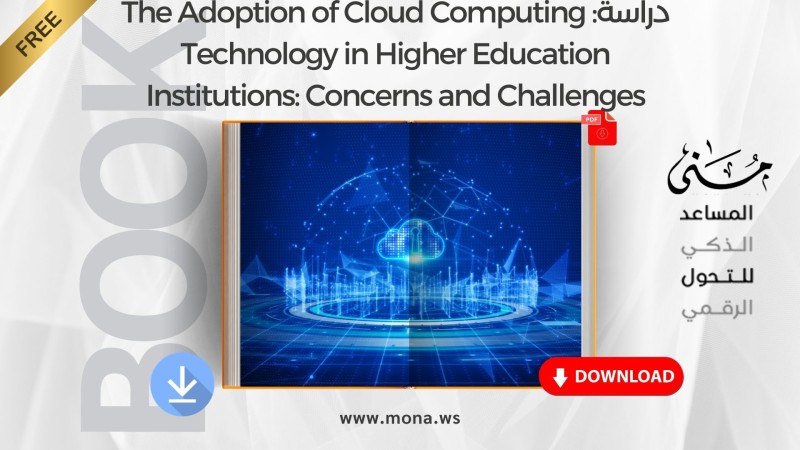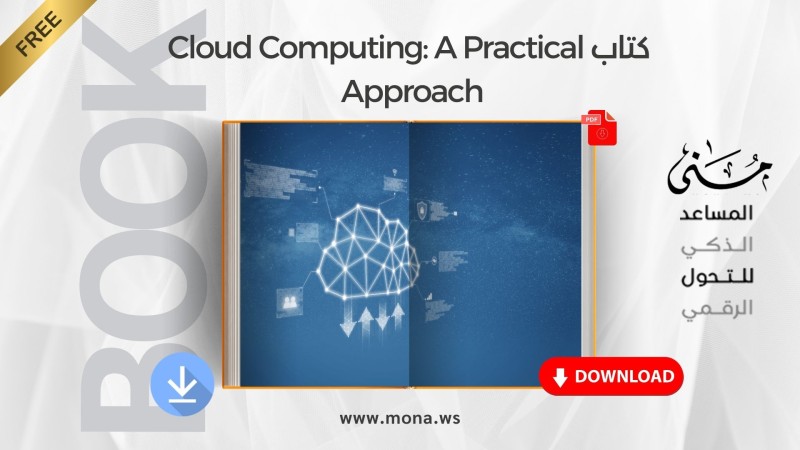study:The Adoption of Cloud Computing Technology in Higher Education Institutions: Concerns and Challenges
Author: Ahmed Gamil Mansour
The study deals withThe Adoption of Cloud Computing Technology in Higher Education Institutions: Concerns and Challenges The concept of cloud computing as a radical technological shift in the way information resources are managed within higher education institutions.
The author defines the technology as a system of software and hardware resources available on demand over the Internet, enabling the use of services such as storage, email, and printing remotely, without the need for expensive local infrastructure.
He confirms thatThe Adoption of Cloud Computing Technology in Higher Education Institutions: Concerns and Challenges represents a golden opportunity for higher education institutions to reduce costs, increase flexibility, and improve the quality of services provided to students and academics.
Study objectives and methodology
The book focuses on a special case study, which is the Islamic University of Gaza (IUG), to analyze its readiness to adopt The Adoption of Cloud Computing Technology in Higher Education Institutions: Concerns and Challenges, the researcher used the descriptive analytical approach through questionnaires distributed to the university’s IT staff, and the results were analyzed using SPSS.
The study aims to determine the university's awareness of this technology, its expected benefits, and the potential challenges faced when adopting it.The Adoption of Cloud Computing Technology in Higher Education Institutions: Concerns and Challenges, in addition to exploring the factors influencing the institutional decision to adopt this modern technology.
The five factors affecting adoption
At the heart of the study, the author focused on five key variables that he believes directly influence success or failure.The Adoption of Cloud Computing Technology in Higher Education Institutions: Concerns and Challenges:
- Senior Management Support
Having a clear and supportive vision from senior management enhances the chances of successful adoption. The more management commitment there is, the faster and more efficient cloud infrastructure investment decisions will be, which will positively impact the process.The Adoption of Cloud Computing Technology in Higher Education Institutions: Concerns and Challenges.
- Integration of cloud services with university systems
It is important that cloud computing services are integrated with existing systems within the university, as successThe Adoption of Cloud Computing Technology in Higher Education Institutions: Concerns and Challenges depends on how easily email, content management, and file sharing integrate into the academic work environment.
- Human resources skills in information technology
Lack of skills can be a major obstacle, so the book stresses the need to qualify employees through training courses and external scholarships, because technical competencies represent the true engine of success.The Adoption of Cloud Computing Technology in Higher Education Institutions: Concerns and Challenges.
- Cybersecurity Effectiveness
Although cloud computing provides high-level security, some organizations are concerned about the possibility of data leakage or hacking. The author has suggested adopting a hybrid cloud model that combines a public cloud for non-sensitive applications and a private cloud for sensitive applications, ensuring security while benefiting from the advantages of...The Adoption of Cloud Computing Technology in Higher Education Institutions: Concerns and Challenges.
- Reduce costs
Reducing costs is a major driver of adoption. Instead of spending on servers and infrastructure, universities can only pay for actual usage, makingThe Adoption of Cloud Computing Technology In Higher Education Institutions: Concerns and Challenges A Smart Economic Solution.
Benefits of Cloud Adoption
The author focuses on a long list of benefits that makeThe Adoption of Cloud Computing Technology in Higher Education Institutions: Concerns and Challenges A Strategic Step:
- Quick access to data from anywhere, anytime.
- Improve corporate performance by reducing reliance on local hardware.
- Enhancing academic collaboration through cloud-based collaborative tools such as:Google Docs and Microsoft Teams.
- Improve time management efficiency, especially during registration and exam seasons.
- Easily expandable without the need to purchase additional hardware.
- Improving user experience in terms of speed, flexibility, and ease.
Potential challenges and limitations
Despite the benefits, the book acknowledges that there are challenges to be aware of, such as:
- Depends on internet speed.
- Legal ambiguity in some countries about where data is stored.
- Some employees resist change for fear of losing their jobs.
- The need to provide backup plans in case the cloud system fails.
The author points out that meeting these challenges requires strategic planning, ongoing training, and proficient risk management.
Practical results and recommendations
The results of the study showed a statistically significant relationship between all five variables and success.The Adoption of Cloud Computing Technology in Higher Education Institutions: Concerns and Challenges, and the researcher also recommended the following:
- Enhance senior management support for cloud transformation plans.
- Improve integration between internal and external systems.
- Investing in human resources training.
- Adopting a flexible hybrid architecture that accommodates data privacy.
- Review security and privacy policies on an ongoing basis.
The book is consideredThe Adoption of Cloud Computing Technology in Higher Education Institutions: Concerns and Challenges is one of the first applied studies in Palestine, opening the door to future complementary studies. Its findings and recommendations could serve as an important reference not only for educational institutions in Gaza, but also for all academic institutions in the Arab world seeking to adopt modern technologies amid limited resources.
The study can be consideredThe Adoption of Cloud Computing Technology in Higher Education Institutions: Concerns and Challenges is a comprehensive scientific and practical guide for universities seeking digital transformation without falling into the trap of uncalculated risks.
You can download the studyThe Adoption of Cloud Computing Technology In Higher Education Institutions: Concerns and Challenges Directly from Here.
 You can download the study The Adoption of Cloud Computing Technology In Higher Education Institutions: Concerns and Challenges directly from here.
You can download the study The Adoption of Cloud Computing Technology In Higher Education Institutions: Concerns and Challenges directly from here.









Comments
Add New Comment